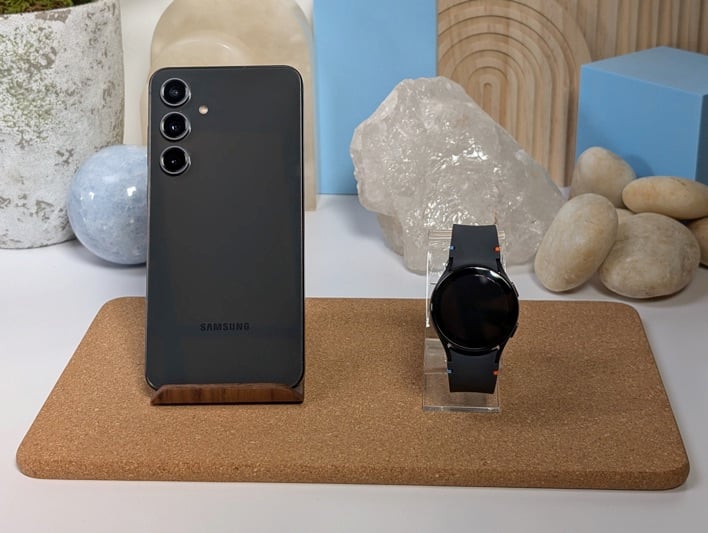Samsung Galaxy S24 FE, Tab S10 Ultra, And Watch FE LTE: Solid Products Powered By A Variety Of Chips

The Galaxy S24 FE Delivers Premium Value

The S24 FE uses the same design language and materials as the S24+. It’s basically an aluminum and glass sandwich, with similar camera surrounds and corner radii – down the slightly rounded edges where the rear glass meets the metal frame. The IP68 rating is identical, too. Bezels are slightly more prominent on the S24 FE than the S24+, especially the chin, so that’s one way to tell these phones apart.
Another difference is the location of the SIM tray (on the top edge on the S24 FE vs. the more customary bottom edge) and mmWave antenna (on the left side vs. the right on the S24+). While it’s slightly thicker (8mm vs. 7.7mm) and weighs more (213g vs. 197g), the S24 FE feels great in hand. Besides those minor cosmetic differences – and the change in display specs vs. the S24+ – there are also a few downgrades.

The S24 FE gets an 8MP telephoto shooter (vs. 10MP), a 10MP selfie camera (vs. 12MP), a 4700mAh battery (vs. 4900mAh), 25W wired charging (vs. 45W), 8GB RAM (vs. 12GB), 128GB of base storage (vs. 256GB), and an Exynos 2400e chip (vs. the S24+’s Snapdragon 8 Gen 3). Is the $350 price difference worth the lesser specs? At first glance, you’re not giving up much, so the value proposition seems worth it.
Performance was fine during our brief time with the S24 FE. The UI was fluid and we didn’t notice any stutter or delays launching apps or using Galaxy AI. Obviously, we don’t expect the Exynos 2400e to match the Snapdragon 8 Gen 3, especially when running benchmarks. Samsung tells us that the S24 FE’s vapor chamber is optimized for gaming, so stay tuned for our review for a proper verdict.

The Galaxy Tab S10 Ultra Focuses On Sustained Performance

Obviously, the big news this year is that the Tab S10 Ultra packs MediaTek’s flagship SoC, the Dimensity 9300+, instead of a Qualcomm processor. When asked, a Samsung exec told us the company picked the Dimensity 9300+ for its higher GPU performance and better thermals under sustained loads. Make of this what you will. Apart from gaining WiFi 7, the rest of the new tablet’s specs are identical to last year’s Tab S9 Ultra.
You get the same lovely and expansive 14.6-inch AMOLED display, same camera system, same battery capacity (11,200mAh), same RAM and storage options, and 5G support. The S Pen is still included, and still latches magnetically to the back of the tablet. As for the keyboard cover, it’s backlit, and it’s been updated with a Galaxy AI key.

Otherwise, the keyboard cover appears to be the same as the one for last year’s Tab S9 Ultra. The keyboard feels nice to type on, but key travel is a little shallow for our liking – at least compared to typing on a modern laptop. We didn’t notice any issues with performance on the Tab S10 Ultra, which is no surprise since last year’s Snapdragon 8 Gen 2 ran everything smoothly, and the Dimensity 9300+ is even quicker.

A Refreshing Variety Of Devices And Chipsets
Finally, we also tried the Galaxy Watch FE LTE, which looks identical to the Watch FE launched in June, but adds 4G cellular connectivity. It’s the same 40mm diameter wearable, with the same 1.2-inch (396 x 386 pixel) Super AMOLED screen, Exynos W920 SoC, and 247mA battery. The Watch FE might be a bit small for people with larger wrists, but otherwise we have no complaints.

And there you have it. Samsung’s latest tablets pack a serious punch, and the FE (Fan Edition) devices are sure to be popular with shoppers who seek a premium experience at lower price points – not to mention carriers (for bundles). The variety of chipsets in these new products is certainly refreshing as well. While the jury is still out on the Exynos 2400e, we’re excited to find out what the Dimensity 9300+ brings to the table.